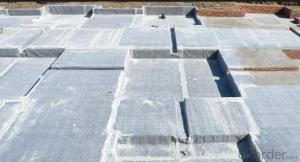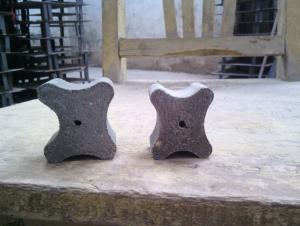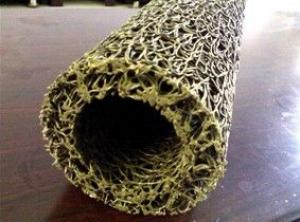GCL Sodium Bentonite Liner Geosynthetic Clay Liners
- Loading Port:
- Qingdao
- Payment Terms:
- TT OR LC
- Min Order Qty:
- 5000 m²
- Supply Capability:
- 100000 m²/month
OKorder Service Pledge
OKorder Financial Service
You Might Also Like
GCL Sodium Bentonite Liner Geosynthetic Clay Liners
Product Introduction
Geosynthetic clay liner is composed of high dilatability of sodium base bentonite filling between the special composite geotextile
and nonwoven fabric, made by the method of acupuncture or suture composite impervious material. Use acupuncture into
geosynthetic clay liner can form many small fiber space, make the bentonite particles can't flow in one direction, when under the
influence of water within the mat forming uniform density of colloidal waterproof layer, prevent the leakage of water.
For different projects,it can combine HDPE liner for better waterproof.
Bentonite has the expansion of the water characteristics. General calcium base bentonite expands, its expansion is only about 3 times
their own size; And sodium base bentonite adsorption 5 times its own weight of water in case of water, Volume expansion to the
original 15 to 17 times above; Lock sodium base bentonite in the middle of the two layers of geosynthetic materials, protecting
and strengthening the role of, Make the GCL has a certain overall shear strength.
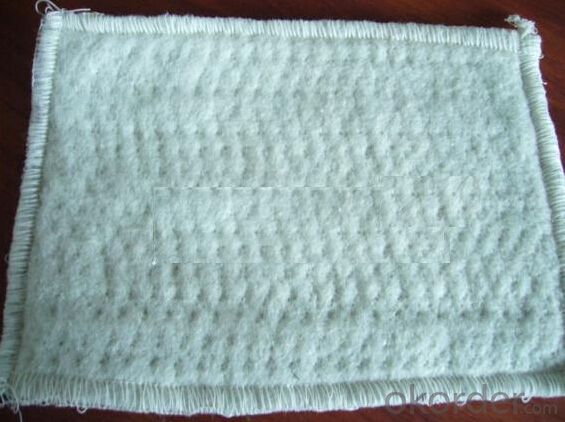
GCL Feature:
1.The permanent waterproof
Because sodium base bentonite is a natural inorganic material, even after a long time or the surrounding environment changes,
also won't happen aging or corrosion phenomena, so the waterproof performance persistence.
2. Compactibility
Sodium base bentonite under water pressure condition to form diaphragm with high density, thickness of about 3 mm,
its permeability is 5 x 10-11 m/SEC below, equivalent to 100 times the compactness of 30 cm thickness of clay,
have very strong since the water retention performance.
3.Not affected by temperature
In cold climates will not brittle fracture.
4.Environmental protection
Bentonite as natural inorganic material, non-toxic harmless to human body, no special effects to the environment,
have good environmental performance.
5.Simple and short time of construction
Compared to other waterproofing materials, construction is relatively simple, don't need to be heated and paste.
With bentonite powder and nails, washers, etc are connected and fixed. After construction does not need special
inspection, if it is found that the waterproof defects and easy to maintenance.
GCL is existing waterproof material in construction period of the shortest.
Specifications
| Property | National standard | Enterprise Standard | Inspection standards |
| JG/T 193-2006 | |||
| Geosynthetic Clay Expansion index | ≥24 ml/2g | ≥25ml/2g | ASTM D5890 |
| Mass Per Unit Area(g/m2) | ≥4000 g/m2 | ≥4000 gm2 | ASTM D5993 |
| Tensile Strength | ≥6KN/m | ≥8KN/m | ASTM 4632 |
| Maximum load elongation | ≥10% | ≥10% | ASTM 4632 |
| Permeability | ≤5×10-11 | ≤5×10-11 | ASTM D5084 |
| Moisture content | ≤15% | ≤15% | ASTM D4643 |
| Peel strength | ≥40N | ≥65N | ASTM D4632 |
| Hydrostatic pressure | 0.4Mp | 0.4~0.6Mp | ASTM D5891 |
FAQ:
How many quantity for one 20'' container?
About 5,000m2, 16rolls
What's your delivery time?
About 15-20days against deposit received
. What's your package?
Per roll with two pieces woven bag
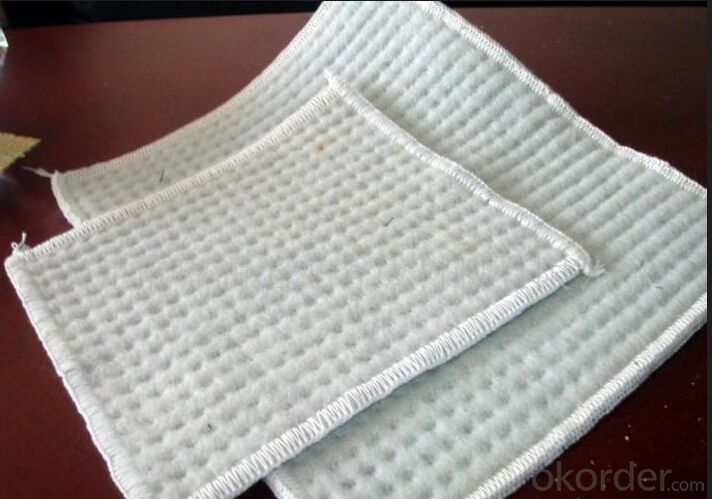
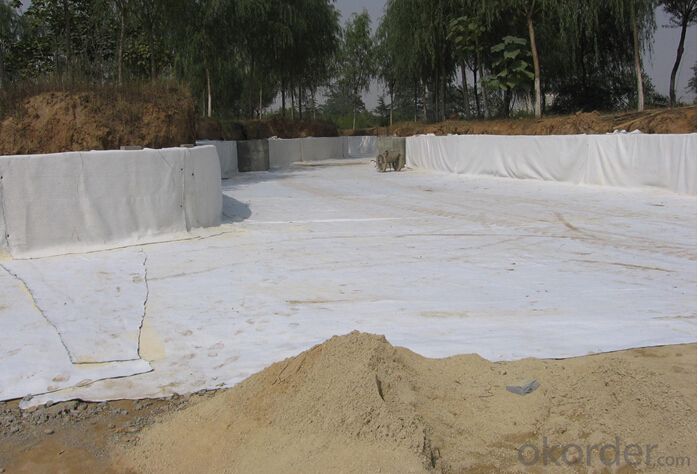
- Q: Can earthwork products be used for storm surge protection?
- Yes, earthwork products can be used for storm surge protection. Earthwork products such as sandbags, geotextiles, and berms are commonly used to create barriers and reinforce coastal areas to protect against storm surges. These products help to absorb and dissipate the energy of the waves, reducing the impact on coastal structures and minimizing flooding risks.
- Q: Are earthwork products suitable for use in riverbank stabilization projects?
- Yes, earthwork products are suitable for use in riverbank stabilization projects. These products, such as geotextiles and geogrids, provide reinforcement and erosion control to prevent the riverbank from collapsing and help maintain its stability. Additionally, earthwork products are designed to withstand water flow and provide long-lasting support, making them a viable solution for riverbank stabilization projects.
- Q: Are earthwork products suitable for use in cemetery construction?
- Yes, earthwork products are suitable for use in cemetery construction. Earthwork products, such as soil, gravel, and stone, can be used to create pathways, build retaining walls, and fill gravesites. These materials are commonly used in cemetery construction to create a stable and aesthetically pleasing environment.
- Q: What is the purpose of using geosynthetic reinforcements in retaining wall construction?
- The purpose of using geosynthetic reinforcements in retaining wall construction is to enhance the stability and strength of the wall. These reinforcements help distribute the lateral forces exerted by the retained soil, improving the overall performance and longevity of the structure. Additionally, geosynthetics can help control soil erosion, minimize settlement, and reduce the risk of wall failure.
- Q: Such as steel, cement, coarse aggregate, fine aggregate, anchor. The The Is it a concrete definition?
- Engineering need to do the re-test of raw materials: steel, brick, cement, sand, stone (if it is not a commodity concrete) waterproof coating, waterproof membrane
- Q: What are the specific applications of geogrids in earthwork projects?
- Geogrids have various specific applications in earthwork projects, including soil stabilization, reinforcement of retaining walls and embankments, erosion control, reinforcing pavements and roadways, and improving load-bearing capacity of foundations.
- Q: Are earthwork products resistant to chemicals and pollutants?
- Yes, earthwork products, such as geotextiles and geomembranes, are designed to be resistant to chemicals and pollutants. They are made from materials that have high chemical resistance and are capable of withstanding exposure to various chemicals and pollutants without degradation or damage. This resistance ensures their durability and effectiveness in preventing environmental contamination and maintaining the integrity of earthwork structures.
- Q: What are the benefits of using geotextile tubes for sediment control?
- Geotextile tubes offer several benefits for sediment control. Firstly, they provide an effective and efficient solution for sediment containment and dewatering. They can be easily installed and quickly filled with sediment, reducing the time and effort required for traditional sediment control methods. Additionally, geotextile tubes have a high dewatering capacity, allowing for the separation of water from the sediment, resulting in reduced disposal costs and improved water quality. Furthermore, these tubes are durable and resistant to UV degradation and chemical exposure, ensuring long-term performance and reliability. Overall, the use of geotextile tubes for sediment control offers cost savings, environmental protection, and simplified implementation.
- Q: Can earthwork products be used in underground utility installations?
- Yes, earthwork products can be used in underground utility installations. These products, such as geotextiles, geogrids, and geocomposites, play a crucial role in providing soil stability, erosion control, and reinforcement to support underground utility installations.
- Q: What are the advantages of using earthwork products?
- There are several advantages to using earthwork products. Firstly, earthwork products are typically made from natural materials, such as clay or soil, which makes them environmentally friendly and sustainable. Secondly, these products are cost-effective as they can often be sourced locally, reducing transportation costs. Additionally, earthwork products have excellent thermal properties, providing insulation to buildings and reducing energy consumption. Lastly, these products are versatile and can be used for various applications, including landscaping, construction, and erosion control, making them a practical choice for many projects.
Send your message to us
GCL Sodium Bentonite Liner Geosynthetic Clay Liners
- Loading Port:
- Qingdao
- Payment Terms:
- TT OR LC
- Min Order Qty:
- 5000 m²
- Supply Capability:
- 100000 m²/month
OKorder Service Pledge
OKorder Financial Service
Similar products
Hot products
Hot Searches
Related keywords














